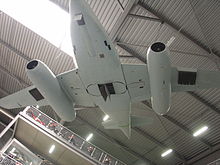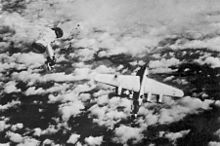| R4M rocket | |
|---|---|
 R4M "Orkan" on display at the German Museum of Technology | |
| Type | Rocket |
| Place of origin | Germany |
| Service history | |
| In service | 1944-1945 |
| Used by | Luftwaffe |
| Wars | World War II |
| Production history | |
| Designed | 1944 |
| Manufacturer | Heber AG, Osterode, Germany |
| Variants | R4M (air-to-air)[1] R4HL (air-to-ground)[1] |
| Specifications | |
| Mass | 3.85 kg (8.49 lb)[1] |
| Length | 812 mm (32.0 in)[1] |
| Width | 55 mm (2.17 in)[1] |
| Muzzle velocity | 525 m/s (1,720 ft/s)[1] |
| Effective firing range | 600–1,000 m (656–1,090 yd) |
| Maximum firing range | 1,500 m (1,640 yd)[1] |
| Filling | HTA 41[a]>[1] (torpex) |
| Filling weight | 520 g (1.15 lb)[2] |



R4M, abbreviation for Rakete, 4 kilogramm, Minenkopf (English: Rocket, 4 kilogram, Mine-head),[1] also known by the nickname Orkan (English: Hurricane) due to its distinctive smoke trail when fired, was a folding-fin air-to-air rocket used by the Luftwaffe at the end of World War II.
The R4M was used on several late war German combat aircraft, most notably the Messerschmitt Me 262, and could be fired from open ramps under aircraft wings or from tubes inside under-wing rocket pods.[1] It featured a high capacity "mine shell" equivalent warhead filled with 520 g (1.15 lb) of the explosive-mixture HTA 41[1] (also known as HTA 15),[2] which consists of 40% Hexogen (RDX), 45% TNT and 15% aluminium.[2] The shell-walls of the warhead were only 0.8 mm (0.0315 in) thick.[1]
Besides the air-to-air warhead the rocket could also be outfitted with shaped charge warheads for air-to-ground use, then called R4HL for hohlladung (English: hollow charge).[1] These warheads were called Panzerblitz (English: Armor-lightning) and existed in two primary versions: Panzerblitz 2 (PB 2), consisting of an 88 mm Panzerschreck warhead fitted with a ballistic cap, and Panzerblitz 3 (PB 3), consisting of the original 55 mm mine-warhead modified to be a shaped-charge.[3][4]
- ^ a b c d e f g h i j k l m "R4M Orkan". germanluftwaffe. Archived from the original on 19 March 2018. Retrieved 22 June 2021.
- ^ a b c d Koch, Ernst-Christian (18 January 2021). High Explosives, Propellants, Pyrotechnics. Walter de Gruyter GmbH & Co KG. pp. 936, 937. ISBN 9783110660562.
- ^ "The Panzerschreck ammunition, Alternative use". bergflak.com. Retrieved 22 June 2021.
- ^ J. Miranda; P. Mercado. Unknown! N.5.
Cite error: There are <ref group=lower-alpha> tags or {{efn}} templates on this page, but the references will not show without a {{reflist|group=lower-alpha}} template or {{notelist}} template (see the help page).